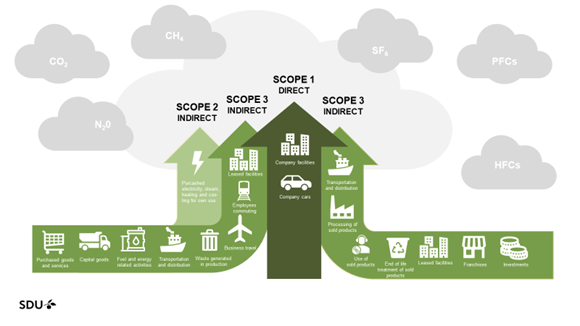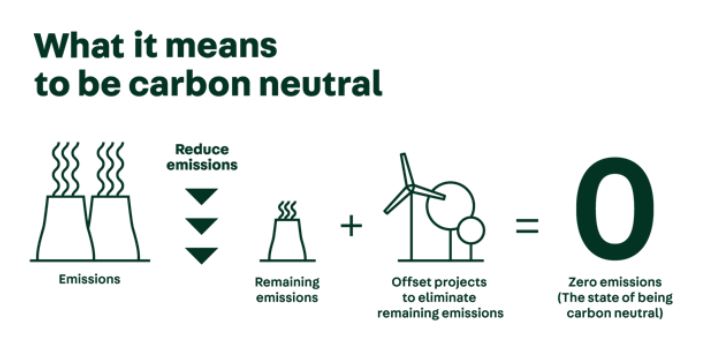What’s a carbon footprint?
Your carbon footprint is a measure of the amount of greenhouse gases that you, your product, or your organisation release into the environment. Calculated in terms of carbon dioxide, your carbon footprint is like a mark we leave on the planet through our activities.
Why does it matter?
Your carbon footprint matters because it quantifies the impact of what you’re measuring on our environment. If you understand your impact, you can reduce it and contribute to a healthier planet. It’s one of the many steps towards environmental responsibility and sustainability. Taking action on climate change now is more crucial than ever because its impacts are accelerating. We’re now experiencing more frequent and severe weather events, rising temperatures globally, and humanitarian concerns due to climate change, resulting in food insecurity, water scarcity and exacerbating poverty.
“We’re the first generation to feel the impact of climate change, and the last generation that can do something about it.”
Barack Obama
Reporting in Scopes
Emissions are categorised and reported in Scopes to ensure there is no double counting. Scopes 1 and 2 are activities the organisation has control over and are mandatory, and Scope 3, reporting indirect emission sources, is voluntary but highly recommended to be included. Scope 3 emissions are required to be reported for any certification.

The process
It takes time and is a bit of a process, but its well worth the effort and does get easier each year. Below the process most carbon footprints take so you know what to expect.
- Establish the timeframe – Decide on the period to measure. This can be either a financial year (FY) or calendar year (CY) and ensure it covers a full 12 months. The initial footprint sets the baseline for all future reporting and progress will be compared to that.
- Choosing the Inventory Type – Decide if you want to measure the organisation’s operations (most common measure), or a specific product or a service. For this article, we’re focusing on the organisation’s carbon footprints.
- Defining the boundary – An organisation is defined by its Australian Business Number (ABN). Determine the most suitable boundary for your emissions – this could be based on operational, financial, or equity control mechanisms. The most common is the operational control boundary. This sets the boundary for your carbon footprint calculation. The next step is to decide which emission sources are relevant and should be included in the inventory. Certain emission sources like energy and company vehicle fuel use are mandatory to be included, others sources should be included if considered material.
- Carbon neutrality consideration – Decide if your goal is to measure and manage your carbon emissions, go carbon neutral, or work towards net zero and carbon netural certification in the future. Just so you understand the difference, carbon neutral is measuring your emissions and then purchasing carbon offsets to ‘neutralise’ what you’ve emitted. Net Zero is measuring your emissions, taking action and reducing what you can, and then purchasing offsets to neutralise the whats left.

- Collect the data – For your selected timeframe, collect the required data to get a comprehensive picture of your carbon impact. The data usually required is:
- Energy data (electricity and gas bills) – kWh / MJ pa
- Refrigerant data (by kg and type of refrigerant off invoices)
- Fuel for company vehicles and onsite stationary energy generation – kL and type of fuel – usually from fuel reports or receipts
- Water data – kL pa from water bills
- Waste – # and type of bins and % full on average, or tonnage by type from waste reports or onsite waste audits
- Business Travel – (flights by class of travel and distance, accommodation by number of nights in hotels and class of hotel) from travel logs, agent reports.
- Taxi travel – km preferred or $ from travel log or expenses
- Freight $ or km and weight from freight logs or expenses
- Paper – # reems purchased/used pa and if recycled or virgin paper
- Employee commute to work km’s and mode of travel – (from staff survey or can use ABS statistical data)
- The remainder is obtained from the Profit & Loss expenses report (excluding all income, staff wages, superannuation, taxes)
- And any other source found to be ‘material’
- Crunching the numbers – The data is analysed and compiled into an inventory and your carbon footprint will be calculated using relevant carbon emission factors. This process involves applying emission factors to the different activities and turning raw data into a clear picture of your organisation’s impact. At the end of the process, you’ll get a number which is the tonnes of Carbon Dioxide equivalent (expressed as t-CO2e) that your organisation has put into the environment – in other words, it’s carbon impact, or footprint. You’re likely to need some professional help with this, particularly for the first one.
- Identify your biggest emission sources – the carbon footprint will identify where your biggest emission sources come from and where you should focus efforts on reducing them.
- Take action to reduce emissions – work out what you can practically do to reduce your emissions. That could be anything from purchasing 100% Green Power and transitioning to electric vehicles, to reducing waste.
- Repeat annually – once you’ve measured it, it’s like financial accounts, the carbon footprint should be done annually.
How much does it cost?
The cost of this process varies based on business size, complexity of the organisation and how much you do yourselves. Carbon Neutral Certification with Climate Active also adds an extra layer of costs which are determined by the size of the organisation and emissions.
How long will it take?
For the initial footprint, you can expect anywhere from 1-6 months from start to finish and this is dependent on how quickly the raw data is obtained. Climate Active Certification extends the initial period to 5-12 months and also depends on data availability. Climate Active recertifications must be done within 4 months of the period end (for example if 30 June 2024 period end date, the recertification must be lodged by 30 October 2024).
Where to get help?
While it’s possible to do your own carbon footprint, it’s best to get an expert help you with the process and calculations, at least for the first few footprints. We’d like to encourage organisations to commit to measuring and managing their emissions. The goal is to not only minimise emissions but also work towards achieving carbon neutrality, and net-zero in the future.
If you need assistance in conducting inventories, creating transition plans, or navigating the intricacies of carbon footprints, we’re here to help. Information on crafting your carbon footprint can be found here. If you’re looking for certification learn more here. Or contact us for a discussion.








